#cemetery monuments long island
Explore tagged Tumblr posts
Text
Design your Gravestone
Want to Design your Own Monument in the Bronx, Long Island NYC area? Cemetery Monument Co., Inc uses the finest quality granite, marble, sandstone, or bronze for your loved one's custom monument. Contact us today!
#Denigris Monuments#NYC Monuments#Gravestones near me#Design your Own Monument#Custom Headstones near me#Cemetery Monuments Long Island#Headstones Long Island#Grave Markers NYC#Gravestone Lettering near me#Design your Gravestone
2 notes
·
View notes
Note
Can you make a post about the evolution of Greek art from the ancient times until now in modern age?
Because we often talk about the evolution of art but unfortunately we don't appreciate after ancient times the other art movements Greece went through the centuries.
That’s true! I am sorry for taking ages to answer this but I don't know how it could take me less anyway hahaha I made this post with summaries about all artistic eras in Greek history. I have most of it under a cut because with the addition of pictures it got super long, but if you are interested in the history of art I recommend giving it a try! I took advantage of all 30 pictures that can be possibly attached in a tumblr post and I tried to cover as many eras and art styles as possible, nearly dying in the process ngl XD I dedicated a few more pictures in modern art, a) because that was the ask and b) because there is more diversity in the styles that are used and the works that are available to us in great condition in modern times.
History of Greek Art
Greek Neolithic Art (c. 7000 - 3200 BC)
Obviously, with this term we don’t mean there were people identifying as Greeks in Neolithic times, but it defines the Neolithic art corresponding to the Greek territory. Art in this era is mostly functional, there are progressively more and more defined designs on clay pots, tools and other utility items. Clay and obsidian are the most used materials.
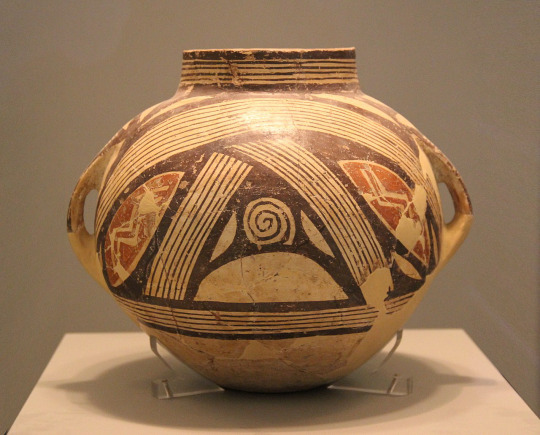
Clay vase with polychrome decoration, Dimini, Magnesia, Late or Final Neolithic (5300-3300 BC).
Cycladic Art (3300 - 1100 BC)
The art of the Cycladic civilisation of the Aegean Islands is characterized by the use of local marble for the creation of sculptures, idols and figurines which were often associated to womanhood and female deities. Cycladic art has a unique way of incidentally feeling very relevant, as it resembles modern minimalism.
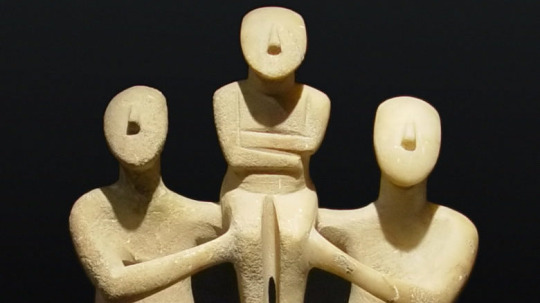
Early Cycladic II (Keros-Syros culture, 2800–2300 BC)
Minoan Art (3000-1100 BC)
The advanced Minoan civilisation of Crete island was projecting its confidence and its vibrancy through its various arts. Minoan art was influenced by the earlier Egyptian and Near East cultures nearby and at its peak it overshadowed the rest of the contemporary cultures and their artistic movements in Greece. Colourful, with numerous scenes of everyday life and island life next to the sea, it was telling of the society’s prosperity.
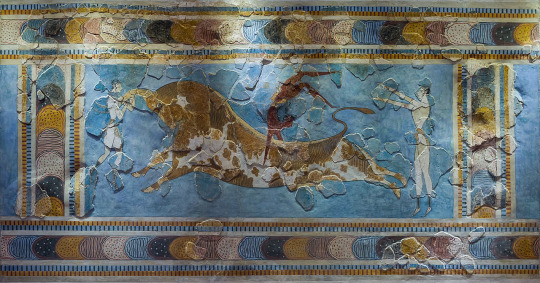
The Bull-leaping fresco from Knossos, 1450 BC.
Mycenaean Art (c. 1750 - 1050 BC)
Mycenaean Art was very influenced by Minoan Art. Mycenaean art diverged and distinguished itself more in warcraft, metalwork, pottery and the use of gold. Even when similar, you can tell them apart from their themes, as Mycenaean art was significantly more war-centric.
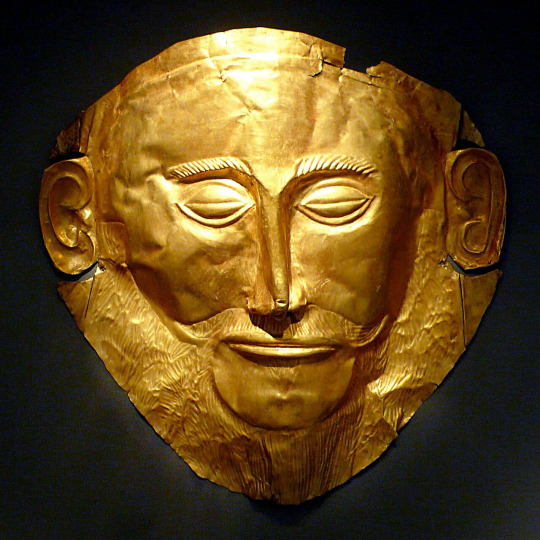
The Mask of Agamemnon in the National Archaeological Museum of Athens. The mask likely was crafted around 1550 BC so it predates the time Agamemnon perhaps lived.
Geometric Art (1100 - 700 BC)
Corresponding to a period we have comparatively too little data about, the Geometric Period or the Homeric Age or the Greek Dark Ages, geometric art was characterized by the extensive use of geometric motifs in ceramics and vessels. During the late period, the art becomes narrative and starts featuring humans, animals and scenes meant to be interpreted by the viewer.

Detail from Geometric Krater from Dipylon Cemetery, Athens c. 750 BC Height 4 feet (Metropolitan Museum, New York)
Archaic Art (c. 800 - 480 BC)
The art of the archaic period became more naturalistic and representational. With eastern influences, it diverged from the geometric patterns and started developing more the black-figure technique and later the red-figure technique. This is also the earliest era of monumental sculpture.
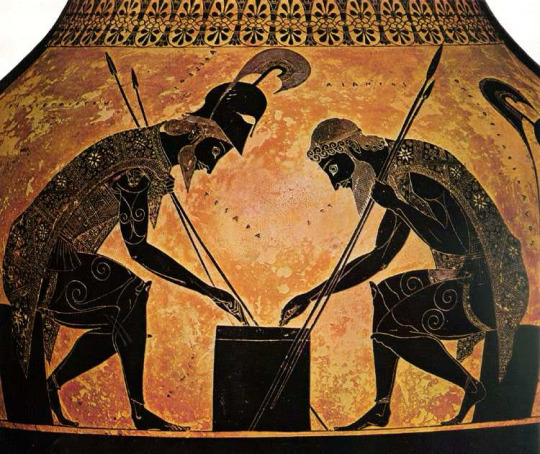
Achilles and Ajax Playing a Board Game by Exekias, black-figure, ca. 540 B.C.
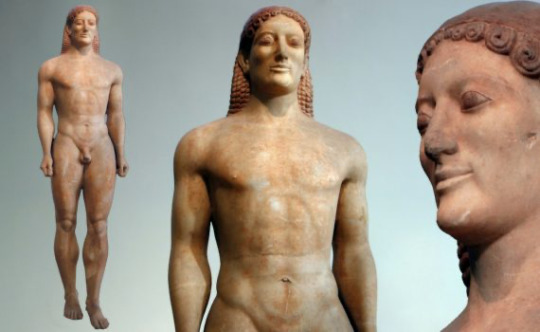
Kroisos Kouros, c. 530 B.C.
Classical Art (c. 480 - 323 BC)
Art in this era obtained a vitality and a sense of harmony. There is tremendous progress in portraying the human body. Red-figure technique definitively overshadows the use of the black-figure technique. Sculptures are notable for their naturalistic design and their grandeur.
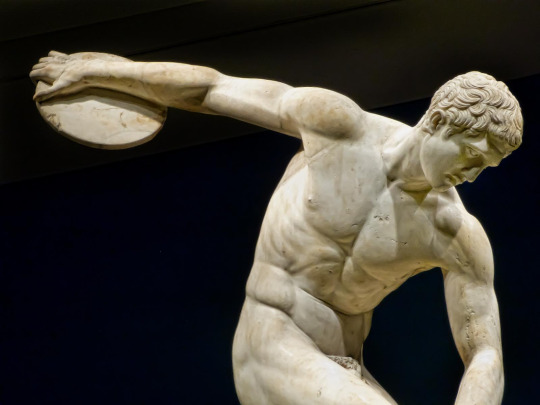
The Diskobolos or Discus Thrower, Roman copy of a 450-440 BCE Greek bronze by Myron recovered from Emperor Hadrian’s Villa in Tivoli, Italy. (British Museum, London). Photo by Mary Harrsch.

Terracotta bell-krater, Orpheus among the Thracians, ca. 440 BCE, The Metropolitan Museum of Art.
Hellenistic Art (323 - 30 BCE)
Hellenistic art perfects classical art and adds more diversity and nuance to it, something that can be explained by the rapid geographical expansion of Greek influence through Alexander’s conquests. Sculpture, painting and architecture thrived whereas there is a decrease in vase painting. The Corinthian style starts getting popular. Sculpture becomes even more naturalistic and expresses emotion, suffering, old age and various other states of the human condition. Statues become more complex and extravagant. Everyday people start getting portrayed in art and sculpture without extreme beauty standards imposed. We know there was a huge rise in wall painting, landscape art, panel painting and mosaics.

Mosaic from Thmuis, Egypt, created by the Ancient Greek artist Sophilos (signature) in about 200 BC, now in the Greco-Roman Museum in Alexandria, Egypt. The woman depicted in the mosaic is the Ptolemaic Queen Berenike II (who ruled jointly with her husband Ptolemy III) as the personification of Alexandria.

Agesander, Athenodore and Polydore: Laocoön and His Sons, 1st century BC
Greco-Roman Art (30 BC - 330 AD)
This period is characterized by the almost entire and mutually influential merging of Greek and Roman artistic expression, in light of the Roman conquest of the Hellenistic world. For this era, it is hard to find sources exclusively for Greek art, as often even art crafted by Greeks of the Roman Empire is described as Roman. In general, Greco-Roman art reinforces the new elements of Hellenistic art, however towards the end of the era, with the rise of early Christianity in the Eastern aka the Greek-influenced part of the empire, there are some gradual shifts in the art style towards modesty and spirituality that will in time lead to the Byzantine art. During this era mosaics become more loved than ever.
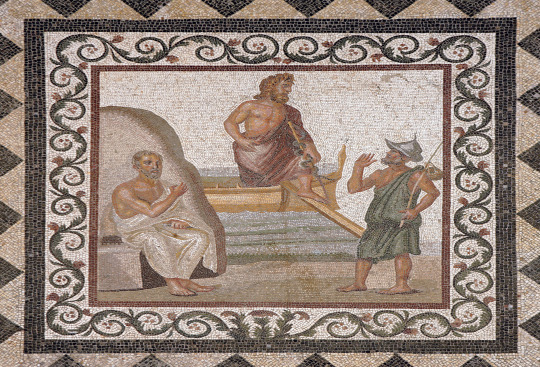
A mosaic from the island of Kos (the birthplace of Hippocrates) depicting Hippocrates (seated) and a fisherman greeting the god Asklepios (center) as he either arrives or disembarks from the island. Second or third century CE.
Introduction to Byzantine Art
Byzantine art originated and evolved from the now Christian Greek culture of the Eastern Roman Empire. Although the art produced in the Byzantine Empire was marked by periodic revivals of a classical aesthetic, it was above all marked by the development of a new aesthetic defined by its salient "abstract", or anti-naturalistic character. If classical art was marked by the attempt to create representations that mimicked reality as closely as possible, Byzantine art seems to have abandoned this attempt in favor of a more symbolic approach. The subject matter of monumental Byzantine art was primarily religious and imperial: the two themes are often combined.
Early Byzantine Art (330 - 842 AD)
The establishment of the Christian religion results in a new artistic movement, centered around the faith. However, ancient statuary remains appreciated. Most fundamental changes happen in monumental architecture, the illustration of manuscripts, ivory carving and silverwork. Exceptional mosaics become integral in artistic expression. The last 100 years of this period are defined by the Iconoclasm, which temporarily restricts entirely the previously thriving figural religious art.

Mosaics in the Rotunda of Thessaloniki, 4th - 6th century AD.
Macedonian Art & Komnenian Age (843 - 1204 AD)
These artistic periods correspond to the middle Byzantine period. After the end of the Iconoclasm, there is a revival in the arts. The art of this period is frequently called Macedonian art, because it occurred during the Macedonian imperial dynasty which generally brought a lot of prosperity in the empire. There was a revival of interest in the depiction of subjects from classical Greek mythology and in the use of Hellenistic styles to depict religious subjects. The Macedonian period also saw a revival of the late antique technique of ivory carving. The following Komnenian dynasty were great patrons of the arts, and with their support Byzantine artists continued to move in the direction of greater humanism and emotion. Ivory sculpture and other expensive mediums of art gradually gave way to frescoes and icons, which for the first time gained widespread popularity across the Empire. Apart from painted icons, there were other varieties - notably the mosaic and ceramic ones.

Paris Psalter, 10th century AD. Prophet Isaiah from the Old Testament in the company of the symbolisms for night (clear inspiration drawn from the ancient deity Nyx) and morning (Orthros, not to be confused with the mythological creature).
Palaeologan Renaissance (1261 - 1453)
The Palaeologan Renaissance is the final period in the development of Byzantine art. Coinciding with the reign of the Palaeologi, the last dynasty to rule the Byzantine Empire (1261–1453), it was an attempt to restore Byzantine self-confidence and cultural prestige after the empire had endured a long period of foreign occupation. The legacy of this era is observable both in Greek culture after the empire's fall and in the Italian Renaissance. Contemporary trends in church painting favored intricate narrative cycles, both in fresco and in sequences of icons. The word "icon" became increasingly associated with wooden panel painting, which became more frequent and diverse than fresco and mosaics. Small icons were also made in quantity, most often as private devotional objects.
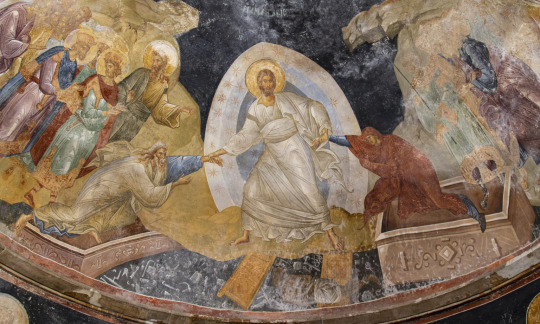
Detail of Anástasis (Resurrection) fresco, c. 1316–1321, Chora church, Constantinople (Istanbul) (photo: byzantologist).
Cretan School (15th - 17th century)
Cretan School describes an important school of icon painting, under the umbrella of post-Byzantine art, which flourished while Crete was under Venetian rule during the Late Middle Ages, reaching its climax after the Fall of Constantinople, becoming the central force in Greek painting during the 15th, 16th and 17th centuries. By the late 15th century, Cretan artists had established a distinct icon-painting style, distinguished by "the precise outlines, the modelling of the flesh with dark brown underpaint, the bright colours in the garments, the geometrical treatment of the drapery and, finally, the balanced articulation of the composition". Contemporary documents refer to two styles in painting: the maniera greca (in line with the Byzantine idiom) and the maniera latina (in accordance with Western techniques), which artists knew and utilized according to the circumstances. Sometimes both styles could be found in the same icon. The most famous product of the school was the painter Domenikos Theotokopoulos, internationally known as El Greco, whose art evolved and diverged significantly in his later years when he moved in Spain and was involved in the Spanish Renaissance, and though it often alienated his western contemporary artists, nowadays it is viewed as an incidental early birth of Impressionism in the mid of the Renaissance’s peak.

Icon by Andreas Pavias (1440-1510), Cretan School, from Candia (Venetian Kingdom of Crete). The Latin inscription suggests the icon was meant for commercial purposes in Western Europe. National Museum, Athens. (Source: https://russianicons.wordpress.com/tag/cretan-school/)

Crucifixion (detail), El Greco (Doménikos Theotokópoulos), ca. 1604 - 1614.
Heptanesian School (17th - 19th century)
The Heptanesian school succeeded the Cretan School as the leading school of Greek post-Byzantine painting after Crete fell to the Ottomans in 1669. Like the Cretan school, it combined Byzantine traditions with an increasing Western European artistic influence and also saw the first significant depiction of secular subjects. The center of Greek art migrated urgently to the Heptanese (Ionian) islands but countless Greek artists were influenced by the school including the ones living throughout the Greek communities in the Ottoman Empire and elsewhere in the world. Greek art was no longer limited to the traditional maniera greca dominant in the Cretan School. Furthermore, the Heptanesian school was the basis for the emergence of new artistic movements such as the Greek Rocco and Greek Neoclassicism. The movement featured a mixture of brilliant artists.

Archangel Michael, Panagiotis Doxaras, 18th century.
Greek Romanticism (19th century)
Modern Greek art, after the establishment of the Greek Kingdom, began to be developed around the time of Romanticism. Greek artists absorbed many elements from their European colleagues, resulting in the culmination of the distinctive style of Greek Romantic art, inspired by revolutionary ideals as well as the country's geography and history.
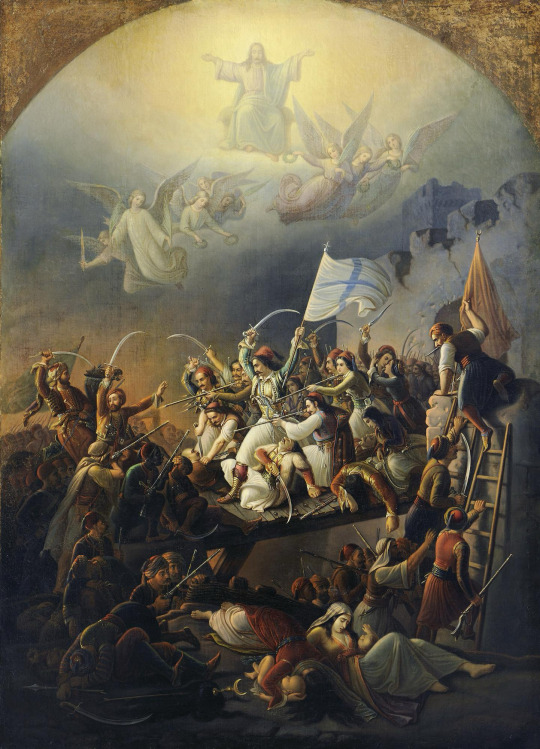
Vryzakis Theodoros, The Exodus from Missolonghi, 1853. National Gallery, Athens.
The Munich School (19th century Academic Realism)
After centuries of Ottoman rule, few opportunities for an education in the arts existed in the newly independent Greece, so studying abroad was imperative for artists. The most important artistic movement of Greek art in the 19th century was academic realism, often called in Greece "the Munich School" because of the strong influence from the Royal Academy of Fine Arts of Munich where many Greek artists trained. In academic realism the imperative is the ethography, the representation of urban and/or rural life with a special attention in the depiction of architectural elements, the traditional cloth and the various objects. Munich School painters were specialized on portraiture, landscape painting and still life. The Munich school is characterized by a naturalistic style and dark chiaroscuro. Meanwhile, at the time we observe the emergence of Greek neoclassicism and naturalism in sculpture.

Nikolaos Gyzis, Learning by heart, 1883.
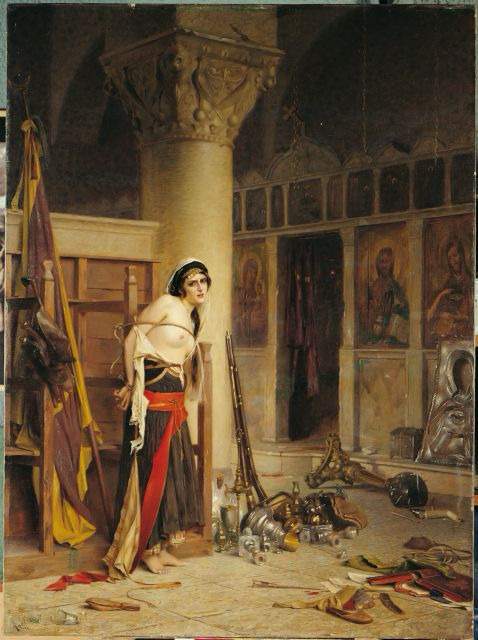
Rallis Theodoros, The Booty, before 1906.
20th Century Modern & Contemporary Greek Art
At the beginning of the 20th century the interest of painters turned toward the study of light and color. Gradually the impressionists and other modern schools increased their influence. The interest of Greek painters, artists changes from historical representations to Greek landscapes with an emphasis on light and colours so abundant in Greece. Representatives of this artistic change introduce historical, religious and mythological elements that allow the classification of Greek painting into modern art. The era of the 1930s was a landmark for the Greek painters. The second half of the 20th century has seen a range of acclaimed Greek artists too serving the movements of surrealism, metaphysical art, kinetic art, Arte Povera, abstract excessionism and kinetic sculpture.
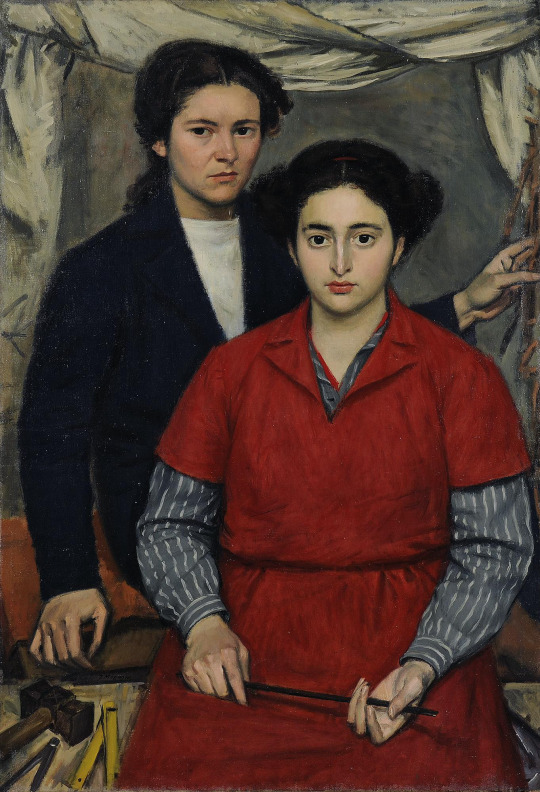
Yiannis Moralis, Two friends, 1946.

Art by Giannis Gaitis (1923-1984), famous for his uniformed little men.

By Yorghos Stathopoulos (1944 - )

Art (detail) by Nikos Engonopoulos (1907 - 1985)
Folk, Modern Ecclesiastical and Secular Post-Byzantine Art
Ecclesiastical art, church architecture, holy painting and hymnology follow the order of Greek Byzantine tradition intact. Byzantine influence also remained pivotal in folk and secular art and it currently seems to enjoy a rise in national and international interest about it.

A modern depiction of the legendary hero Digenes Akritas depicted in the style of a Byzantine icon by Greek artist Dimitrios Skourtelis. Credit: Dimitrios Skourtelis / Reddit

Erotokritos and Aretousa by folk artist Theophilos (1870-1934)

Example of Modern Greek Orthodox murals, Church of St. Nicholas.

Ancient Greek philosophers depicted in iconographic fashion in one of Meteora’s monasteries. Each is holding a quote from his work that seems to foreshadow Christ. Shown from left to right are: Homer, Thucydides, Aristotle, Plato and Plutarch. This is not as weird as it may initially seem: it was a recurrent belief throughout the history of Christian Greek Orthodoxy that the great philosophers of the world heralded Jesus' birth in their writings - it was part of the eras of biggest reconciliation between Greek Byzantinism and Classicism.

Prophet Elijah icon with Chariot of Fire, Handmade Greek Orthodox icon, unknown iconographer. Source
If you see this, thanks very much for reading this post. Hope you enjoyed!
#greece#art#europe#history#culture#greek art#artists#greek culture#history of art#classical art#ancient greek art#byzantine greek art#christian art#orthodox art#modern art#modern greek art#anon#ask
65 notes
·
View notes
Text
Stone Monument Conservation
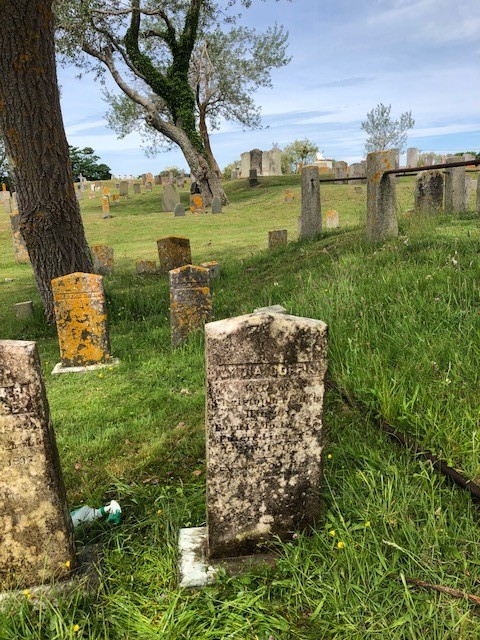
On Saturday, June 10, the MMA in conjunction with the Prospect Hill Cemetery, will offer our yearly stone monument conservation workshop. In 2022, we cleaned the stone of Lydia Coffin Hussey. (Seen in image after cleaning - but before the solution does its real magic.) Why? Because the MMA has in its collection a small wooden marker which was likely discarded and found at the dump. On it was a number and Lydia Coffin Hussey’s name written in pencil. Likely, this marker was placed at her burial site until a stone could be erected – in order to mark her gravesite though it’s in a larger family plot. With a little digging – in great part thanks Tuck’t In by Prospect Hill Cemetery historian, Paula Lundy Levy – we were able to glean some basic details about her. She married the Reverend Christopher Coffin Hussey – yes, Coffin was in both their names, small island – and they had three daughters – two of whom are buried in the lot. One died at age 16; the other at age forty-four – she may have married or been single. If she was married and died before her husband, burying her in her family’s plot makes sense. (Sally Mitchell Barney – Maria Mitchell’s oldest sister – died before her husband. She was buried in the Mitchell family plot and her husband remarried. When he died, he was buried in his second wife’s family plot.)
Lydia’s husband, Christopher, while raised as a Quaker would later become an ordained Universalist minister with parishes off-island. He also was a collector of island stories and after his death, a book he was working on, was completed by Lydia and published in 1901. I believe Lydia may not have had a marker for a long time because she died before at least two – if not all three – of her children. That may have left her with no one to oversee a proper internment. In Tuck’t In there is mention that records show the stone was still not there in 2007 – but I believe the records are likely wrong as the stone is there. Last year, we cleaned it. This year we hope to clean the stones of her two daughters who are interred in the plot (at rear in image).
Please join us. Registration is necessary and available on the MMA website at: https://112458a.blackbaudhosting.com/112458a/Preserving-the-Monuments-of-Our-Ancestors-How-to-Properly-Clean-Historic-Gravestones
Note: We utilize a special cleaner made for stone monuments and a proper conservation process. One must be trained in such cleaning and in using the proper tools and cleaner. One must also have permission form the cemetery to clean a stone – even of one’s own family – and one must never clean stones without permission from family members or descendants. Of further note: in many places, gravestone rubbings are illegal – it destroys the stone.
JNLF
#Nantucket#Maria Mitchell#Nantucket Maria Mitchell Association#historic stone monuments#historic gravestones#historic gravemarkers#historic cemeteries#Nantucket Prospect Hill Cemetery#gravestone cleaning#gravestone conservation#stone monument conservation
2 notes
·
View notes
Photo

Located on a hill of significance in Brooklyn’s Green-Wood Cemetery on the Plateau or Battle Hill is the 35 foot tall Civil War Soldiers Monument which was erected in 1869 four years after the war. The significance of the hill goes back to the American Revolution, during the Battle of Long Island on August 27, 1776 where the British engaged General George Washington’s Troops. The Civil War monument was dedicated by the City of New York to honor its dead fallen heroes and the 148,000 soldiers who enlisted for service in the Civil War. The elegance of the polished gray granite, the four cast zinc life-size soldiers standing at its base are a stark reminder when American fought American and in the end the Union was preserved but at a costly price of many many lives to which this monument honor their sacrifice. - [x] #developportdev @gothamtomato @developphotonewsletter @omsystem.cameras #excellent_america #omsystem @bheventspace @bhphoto @adorama @tamrac @tiffencompany #usaprimeshot #tamractales @kehcamera @mpbcom @nycurbanism @nycprimeshot @historicgreenwood @nybucketlist #omd #microfourthirds #micro43 (at Green-Wood Cemetery) https://www.instagram.com/p/CpLBf0AuAPD/?igshid=NGJjMDIxMWI=
6 notes
·
View notes
Text
Day 4, Fri. Sept 8: Portsmouth, NH to Uxbridge, Massachusetts (168 km) to Charlestown, RI (258 km) to Branford, Conn (396 km).
Massachusetts is a beautiful state, but as one sign suggested, it is "thickly settled." Even though I gave Boston a wide berth, it felt like one long drive from Toronto to Hamilton along Lakeshore Drive. Endless beautiful homes, but oh, so many cars, stop signs, and slow speed limits. Even though Worcester is 50 miles west of Boston, it still felt like I was driving through one huge, well-off, Boston bedroom community. Not until Farmington, some 90 miles away, did the effect seem to fall off. So, in a word, beautiful homes and scenery, but I won't be planning too many future rides through Massachusetts.
Once past Farmington and heading to Uxbridge, the Boston effect started wearing off. Speed limits went from 35 to 50 mph and while not necessarily wall to wall, beautiful, New England homes, still lots of pretty Normal Rockwell scenery and buildings.
Although I did get an early start today, it still takes me most of the morning to ride the 168 km to Uxbridge (pop 14,200), where I cross the border to Rhode Island. Interestingly, Uxbridge is named after the Earl of Uxbridge and was first colonized in 1662 . It is often referred to as "a Cradle of the Industrial Revolution" as it was a prominent textile center in the American Industrial Revolution.
Once across the border, I head due south towards Charlestown. On the way, I stop at the Rhode Island Veterans Memorial Cemetery in Exeter. Its 280 acres of beautifully maintained grounds include 41 monuments and 40,000 gravestones. Family members may need to pay, but if you are a veteran, you receive internment here for free.
Once in Rhode Island and away from Boston, the roads open up but are still filled with homes, but it is much more like driving through country acreages. I make good time to Charlestown, home to one of the finest collections of beaches in Rhode Island. In fact, according to the United States Census Bureau, the town has a total area of 59.3 square miles, of which 36.8 square miles is land and 22.5 square miles is water. I find a small cove, and after having my lunch overlooking the water wash off my hands in the Atlantic Ocean.
From Charlestown, I head west towards Branford, Connecticutt. Like Rhode Island, Connecticutt is a pretty and more open drive. I spend a lot of my afternoon riding on shady forested roads with a generous sprinkling of classic New England towns, buildings, and homes. I get a nice surprise in Hadlyme as I stumble across the historic Hadlyme- Chester. First established in 1769, it is the second oldest continuous running ferry in Connecticutt. Of course, instead of going around, I take it across the Connecticutt River. It takes half an hour off my ride to Branford, and I end up making good time and staying dry.
Branford itself is a shoreline town located on Long Island Sound in New Haven County, about 6 miles east of downtown New Haven. It gives me a nice taste of Connecticutt without having to go into any of the major cities. Its population was only 28,273 at the 2020 census.
I settle into my usual post ride routine and, thinking about the weather, grab an early dinner. On the way back, I cover up my seat and grab my rain gear out of the bike. From the looks of that sky, I'm going to need it tomorrow.



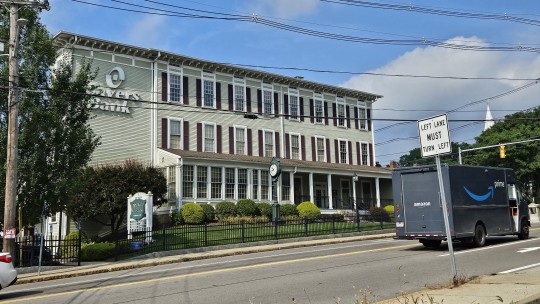
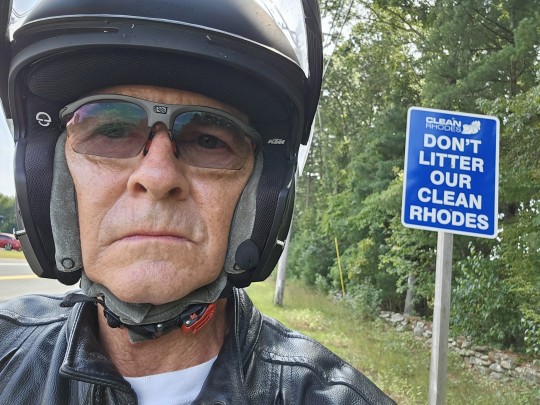

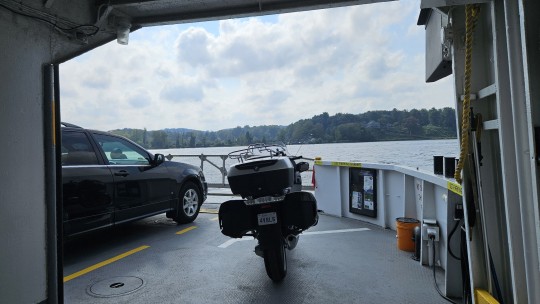
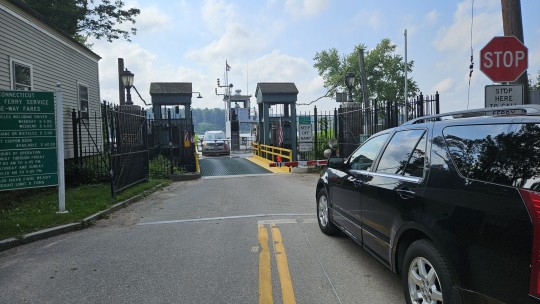
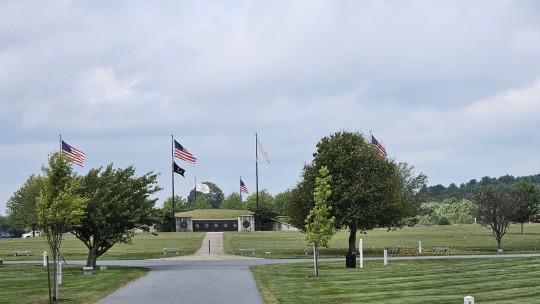


0 notes
Text
HMS TAMAR Crew Rededicates WWII POW Memorial
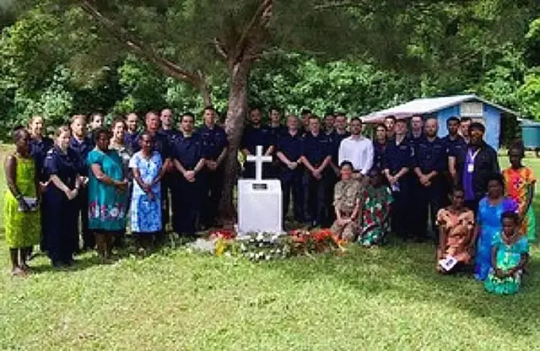
A Long-Awaited Tribute to the Royal Artillery POWs
In a poignant ceremony on Ballalae, Shortland Islands, the crew of HMS TAMAR, a Royal Navy vessel, refurbished and rededicated a memorial honoring 517 British soldiers who were prisoners of war during World War II. Eighty years after these brave soldiers were executed by the Japanese Imperial Forces, the ceremony served as a heartfelt tribute to their sacrifices and an opportunity for reconciliation and remembrance.
A Tragic History Unveiled
The story traces back to November 1942 when 517 soldiers of the Royal Artillery, who had been captured during the fall of Singapore earlier that year, were transported to the Island of Ballalae. The Japanese captors forced them into constructing an airfield, referred to as an 'unsinkable aircraft carrier,' in the unforgiving tropical climate. Months of relentless forced labor, coupled with brutal tropical conditions, took a severe toll on the prisoners. Many succumbed to exhaustion and tropical diseases, while others perished due to Allied bombings. Adding to their misery, their captors forbade them from building trenches to protect themselves during bombings. As the Allied forces liberated the South Pacific islands in 1943, the Japanese Commanders on Ballalae feared imminent capture and, in a horrific act, executed the remaining 57 prisoners.
Discovering the Tragedy
Following the liberation, the United States forces bypassed Ballalae, leaving the island to deteriorate. It wasn't until 1945 that the first Allied forces landed on Ballalae and discovered the remains of the 57 soldiers in shallow trenches. An investigation, conducted by an atrocities commission, led to the discovery of a mass grave containing 436 bodies identified as British artillerymen. Later, the authorities re-interred these fallen soldiers in separate graves at the Bomana War Cemetery near Port Moresby, Papua New Guinea. Each grave bore a solemn inscription, 'Here lies a Soldier, known only to God.'
A Pilgrimage and a Fading Tribute
In 2003, three relatives of the POWs undertook a pilgrimage to Ballalae to honor their fallen ancestors. They dedicated a memorial at the airstrip in the form of a cairn, featuring a wooden cross and a plaque donated by the Royal Artillery Association. Regrettably, as the site was not a registered Commonwealth war grave, it did not receive regular maintenance, and by 2007, the memorial had fallen into disrepair.
A Renewed Dedication
Enter Mr. Phil Jones, an ex-British serviceman working in the Solomon Islands as part of an Australian government mission. Recognizing the importance of preserving the memorial, he generously rebuilt it with an iron cross atop a concrete plinth, preserving the remains of the old cairn.
A Touching Ceremony of Remembrance
Fast forward to 2023, marking 80 years since the tragic events of 1943, the British High Commissioner to the Solomon Islands, His Excellency Thomas Coward, seized the occasion during HMS TAMAR's visit to the islands to maintain the monument. Amidst the scenic coral beach of Ballalae, the High Commissioner and HMS TAMAR's Captain, Commanding Officer Teilo Elliot-Smith, received a warm welcome from the local community in Shortlands. With the crew's concerted effort, rust and grime accumulated over 16 years were removed, restoring the memorial to its former glory. A poignant service of re-dedication followed, paying solemn homage to the soldiers who had lost their lives on the island. A Timeless Tribute HMS TAMAR's Chaplain, Reverend Mick Uffindell, officiated the re-dedication service, with the ship's crew and local community representatives attending. In the touching ceremony, the British High Commissioner, His Excellency Thomas Coward, and HMS TAMAR's Executive Officer, Lieutenant Commander Matt Millyard, reverently laid traditional remembrance red poppy wreaths. The Solomon Islanders also contributed to the homage, presenting handmade floral bouquets. The refurbishment and re-dedication of the memorial stand as a poignant testament to the enduring bond between nations and the timeless tribute to the brave souls who paid the ultimate sacrifice. In commemorating these fallen soldiers, the event reaffirms the importance of honoring the past while building bridges for a peaceful future. Sources: THX News & British High Commission Honiara. Read the full article
#AlliedForces#BallalaeMemorial#BritishWWIIPOWs#HMSTAMAR#HMSTAMARCrew#PacificIslands#RededicationService#RoyalArtillerySoldiers#SolomonIslands#WarCemetery#WorldWarII
0 notes
Text
2023 Bahama Cruise, Part 19 Apr. 16. Driving north Long Island.

After a rainy day on Long Island the weather was starting to look like it was breaking up. So early the next day we rented a car and drove north on Long Island. Taking any side road we thought looked interesting. Here Nancy is about to check out a small beach at the very north end of Long Island.

This is the Morris Pyramid Tomb. Where in 1794, John Morris buried his 14 year old daughter on the plantation. This is a national historic site in the Bahamas. The original engraved marble head stone had gone missing in the 1960’s. Then found and reassembled for a dedication in 2012. It must have been a heck of a dedication. There is still a set of wooden bleachers at the site, now overgrown.


Orchids grow wild here in the lower elevations. We look for airplants along the edge of side roads. Then we slow down and start looking for orchids. Multiple spikes of flowers. Just a month too early to see.

This is looking south at Cape Stella Maris resort. Rain clouds surrounded us. We thought it was going to be a 1.4 mile hike to the Columbus Monument. So we took a break and had lunch at the resort. Cracked conch appetizers, and a Kalik beer.
The sailboats in Calabash Bay were rolling about. That is why we decided to drive and not sail. Just before we found the road to the resort, was the road to the Adderly Plantation. It was flooded so we passed on that.


Everything we researched, said you parked at the dinghy dock and walked 1.4 miles to the monument. The road looked pretty good so we kept driving. Turns out the road has been recently enlarged and paved. So far the best road by far, we have driven on. The Lucayan / Columbus Monument had parking and great concrete stairs leading to it.

At the base of the stairs you can walk out to a small beach. We found more shells and sea glass on 200 ft. of sand than on miles of other beaches. Rain showers were threatening us. So we got back in the car and explored some more side roads.
Roads on Long Island are full of pot holes. I finally broke the code while driving. If you see a fresh pile of rock and sand next to the road. That part of the road is particularly full of pot holes and this was dumped in advance to fill the holes. So slow up and be prepared to zig zag around multiple pot holes.
We had driven 65 miles of the 75 mile road and had never seen a Kapok tree. Nancy says, “I think I just saw a Kapok tree”. You don’t see many anywhere. So I turned around and we did not see a Kapok tree anywhere. So we start back in the direction we were going. Shortly there is the first Kapok tree we have seen on the island. This is weird, she thinks something and then it appears. I am now thinking, TWILIGHT ZONE!

These are West Indian Whistling Ducks, and yes they whistle. Ronald who owns a local restaurant has set up a nature preserve across from his house for the ducks.


This is Seymour’ public cemetery in the north part of the island. Several old graves were just covered by loose rocks. It did have the best looking wall we have seen at the cemetery’s. Conch shells were concreted in the top. Again graves all face east.

This is the gate for the road to Sharie and James Knowles. Note the orchid they placed on the palm tree.
When we got back to Thompson Bay we took a long side road to Tiny’s Hurricane Hole. Two degrees of separation on Long Island. The couple sitting at the bar next to us was from “SouleMate”. Which is the sailboat that anchored next to us earlier in a secluded bay. Put a couple of sailors in a bar together and they start talking weather, routes, charts etc. If you have been where they are going, you tell them about what to see and do. And they do the vice versa. I end up talking to the Navigator. Many times it is the wife, who is the planner and navigator. So Karen and I traded knowledge. Then Sharie and James Knowles came in with their family. We had spent a day with them earlier. Their gate sign is above. Two degrees of separation!

Next morning we had a 0500 wakeup. By 0530 we were headed west to sail up Comer Channel and around the west side of Great Exuma. Sun came up an hour after we started sailing. The “Southern Comfort” fishing boat passed us a couple of hours later. He had so many Crawfish condos stacked all over his boat, I am not sure if he saw us.
We are motor sailing downwind for hours. The mind wanders. For what ever reason, the scene out of “Master and Commander” of the old sailor holding out both fist came to my mind.. Something grisly was about to happen and he was semi lucid. The fist on the left looking at you had a tattoo across his knuckles, “H..O..L..D”. I could not come up with the tattoo on the knuckles across the right fist. “HOLD”… “ TIGHT”? No not enough knuckles.
“HOLD”… “TITE”? No it was not abbreviation.
Spent an hour trying to figure out what it could be. Oh well, I give up.

With good visibility and Nancy on the bow pointing the way. We snaked our way through Jewfish Cut. Then continued north for 2 more hours. Anchoring in the lee of Rocky point.

Rocky Point is out in the middle of no where. But it is a common waypoint between two long legs of sailing. We arrived early with a heavy chop and stiff wind. I made water for two hours in between rain storms. Nancy paddled up to the island and then around the whole island.
One large shark eased by our boat and went to check out Nancy and her paddleboard.
Nancy was just coming back when a sailboat with a single hander sailed in.
I had my own Twilight Zone moment. When the solo sailor passed us up and pressed up closer to the island. I could read the boat name on the stern. “HOLD FAST”. That was the tattoo, “H..O..L..D - F..A..S..T”
What are the odds? You can’t make this stuff up. Myron Coelho dinghied over and introduced himself. An extremely bright and interesting man, who is down to earth. We killed a bottle of rum, discussing the worlds problems and history. He had multiple Masters degrees in the engineering field. Built his own Lithium batteries and water maker for his boat.
Early the next morning he stopped back by to say good by. We parted ways heading in different directions, having so much in common. Best wishes Myron, looking forward to crossing paths again.


Nancy having a great day! She came back to the boat after paddleboarding and cleaned the side of the boat while using her suction cup hand hold.
We were enjoying our own peaceful anchorage. So we stayed an extra day with Nancy doing hand washing clothes in the sink and I made water for 3 hours. Nancy paddleboarded around the island again. This time she spooked a small Lemon shark, who did not know what to do trapped in the shallow enclosed water. He literally jumped on top of her inflatable paddleboard, then flopped back in the water. Sharks and inflatables just don’t mix well. No harm, no foul.
We left early the next morning for Cave Cay.
Speaking of crossing paths. Next is “Bay Wind”…….
Sea Breeze, Rocky Point, Great Exuma, Bahama.
1 note
·
View note
Text
Wave Organ-San Francisco
It’s a truly unique audio experience, something like listening to the world’s largest seashell. Some say it sounds like distant drums, others refer to it as quiet thunder, and the fifty-something-year-old hippie standing next to us, with the tie-dyed bandana covering up a huge bald spot on what was probably once a magnificent head of free-flowing hair, says it sounds “soooooo cooool” between tokes of his specially rolled cigarette.
This visual experience is none too shabby either. Located at the very end of a jetty in San Fracisco’s Golden Gate National Recreation Area, amid the panorama of the Golden Gate Bridge, Alcatraz Island, and the city skyline, sits little-known place of interest: the Wave Organ.
Created in 1986 by artists Peter Richards and George Gonzales, the Wave Organ is a “wave-activated acoustic sculpture.” There is an undeniably otherworldly, ethereal quality to this very impressive work of auditory physics. That may be because many of the granite and marble stones used to create this monument to the ocean’s reverberations came from a cemetery that dates back to the gold rush.
Dozens of long PVC pipes are situated at various locations and elevations along the edge of the small peninsula. The listening ends of these pipes are positioned all along the isthmus and inside a specially constructed stereo booth. When the wave crash against the open ends of the pipe and the consequent interchange of the bay water flows in and out of the tubing, a wonderfully calming and naturally piece of music is produced.
It is best to visit the Wave Organ at high tide, and that can be odd hours, depending on the time of the year. But odd hours in San Francisco are never dull hours; we’re sure you’ll find something to do while waiting for the tide to come in.
0 notes
Photo

10-25-1861 - The keel of the Union ironclad Monitor was laid at the Continental Iron Works at Greenpoint, Long Island. "USS Monitor was the brainchild of Swedish-American inventor John Ericsson. The U.S. Navy built Monitor in response to the Confederate threat of an ironclad vessel rising on the ways at Gosport Navy Yard in Portsmouth, Virginia in 1861. The Confederate ironclad ship, built upon the bones of the scuttled steam-screw frigate Merrimack, would ultimately bear the name CSS Virginia and would meet Monitor in a watery battlefield off of Hampton Roads, Virginia on March 9, 1862 in the first-ever battle between ironclad warships." [Source Arlington National Cemetery . https://www.arlingtoncemetery.mil/Blog/Post/10995/The-Monitor-Is-No-More-Honoring-the-Lost-Men-of-USS-Monitor ]
A small monument in Section 46 of Arlington National Cemetery honors sixteen men from the Civil War ironclad USS Monitor who perished in the sinking of the vessel in a gale off Cape Hatteras, North Carolina on New Year's Eve, 1862.
2 notes
·
View notes
Text

Request: “Can you do fluffy Hibana x reader Hc? 👉👈”
Pairing: Hibana x Reader
A/N: I got so excited when I got this request because I just read her character profile the other day and found out one of her hobbies is video games! I had a lot of ideas for fluffy Hibana so it’s a bit long, haha.
When you’re both in public, Hibana’s presence is dominating and she demands respect from everyone around her. She is Company 5’s Captain first and she refuses to show anything that could be seen as a weakness to be exploited by her enemies.
That being said, she does enjoy public displays of affection - especially when it comes to staking her claim on you and making sure everyone knows you are a very happy couple. You will never see her show her soft side in public though.
When it’s just you two behind closed doors, however, it’s a completely different story. No one would ever believe you but Hibana is a complete softie. She’s still her flirty, dominating self but she is also excitable, affectionate, and cute.
Once you two have your privacy, she is in your embrace, demanding your attention like a needy kitten. She wants to feel your arms around her, she wants to hear your voice telling her everything about your day, and she wants to talk to you about her recent scientific endeavors.
She absolutely melts under your praise, turning into a smiling mess as she showers you with affection. She doesn’t respect any of this gravel but she loves and respects you and praise coming from you always made her happy.
“Tell me more about how amazing I am~” she’ll tease as she presses a dozen kisses to your face.
Hibana is a scientist but, when it’s just you two, she is such a huge nerd about it. She will go on tangents about her latest experiments, geeking out about the technical details and gushing about how fascinating her results are. She loves when you listen to her intently, even if you don’t understand half of what she’s saying, and she especially loves when you ask her questions.
She likes being able to show off to you how much of a genius she is. If you praise her during these moments, complimenting her on her ingenuity and her research, her smile shines like the sun.
“Your Muse is an absolute genius, who else but me could make such incredible discoveries?”
Hibana loves to play video games with you. It’s her biggest hobby after her scientific exploits and she enjoys being able to share that time with you.
Her absolute favorite game is Animal Crossing. Her island is incredible and, unsurprisingly, princess themed. She’s always sending you expensive gifts in game and giving you all her duplicate recipes.
Her second favorite game is Minecraft and you have your own server together that you started from scratch. You worked together to build an entire sprawling city, dotted with monuments dedicated to each other.
You both tried to play video games like first person shooters and fighting games but she is way too competitive and matches may have, embarrassingly enough, lead to real life arguments and grudges.
Hibana once pouted so hard she gave you the silent treatment for an entire night after you kicked her ass in Smash.
You both decided it was for the best to either play co-op games or games where you could pass the controller.
Some of the times you’ve laughed the hardest together was when you created the weirdest looking characters you could in games like Skyrim and Dragon Age.
Hibana will always have a feast of snacks and drinks for you both on game night. You’ll both happily munch on anmitsu, cookies shaped like flowers, and other sweets while gaming together. If you don’t have a sweet tooth like she does, she’ll have plenty of your favorite snacks just for you.
Speaking of food, Hibana will make you the most amazing meals you’ve ever eaten. She enjoys cooking for you and will set aside the time to learn new recipes and make you lunches. She even goes as far as to make them pretty, cutting the food into hearts and making cute faces. She goes all out for dinners, especially on special occasions, and you are spoiled rotten.
When it’s time to curl up for the night, Hibana is a huge cuddler. Even if it was sweltering hot, she needs to be touching you somehow to sleep. She feels safest and happiest wrapped up in your arms and the sound of your soft breathing is her favorite lullaby.
She will also frequently steal all of the blankets in her sleep and leave you with the fitted sheet. When you call her out on it, she’ll say that she’s a princess so what did you expect.
You’ll never tell her but she sleep talks and it is absolutely adorable. She talks about science mostly, rambling about whatever problem she went to sleep thinking about, but she also brags about you.
Sometimes she will cackle like she is possessed in the middle of the night, scaring you half to death, before going back to a perfectly peaceful slumber. (Sol knows what she’s dreaming about.)
Hibana sometimes gets nightmares, something she doesn’t like to talk about. With the easier ones, where you wake up to her trembling and twitching, you’ll kiss her temple and whisper to her that you love her and she’s safe. She’ll rouse just enough to escape the nightmare and return to pleasant dreams before you follow.
During the bad ones, you’ll have to shake her to wake her up. After startling awake, she’ll silently curl up in your embrace and you’ll rub your hand down her back until she falls back asleep against you. She tells you one day it’s a recurring nightmare about her covenant burning and that’s all she’ll say about it for a long time.
When you’ve been together for some time and she trusts you completely, she’ll finally open up to you about what happened.
When Hibana knows she wants to spend the rest of her life with you, she’ll take you to the cemetery to meet all of her sisters. You’ll help her decorate the graves to a ridiculously lavish extent and, when you bring little gifts for all of her sisters, she cries in front of you for the first time.
Iris is the only family that she has left and, when you two make friends, she is grateful that the people she loves get along. Iris is also an endless source of adorable stories and an afternoon spent with her is an evening spent teasing your furiously blushing lover.
Hibana may have a complicated relationship with her faith but she is grateful to whatever god might be listening that you came into her life.
#hibana#princess hibana#hibana x reader#fire force x reader#fire force#enn enn no shouboutai#fanfiction
98 notes
·
View notes
Text
Design Your Memorial to Honor Loved Ones with a Cemetery Monument
When it comes to commemorating the lives of loved ones, selecting the perfect monument is a deeply personal and meaningful process. Whether you're looking for cemetery monuments in Long Island, headstones in Long Island, or seeking to design your gravestone, Cemetery Monument offers the expertise and skills needed to create a lasting tribute.
Why Select Cemetery Monument?
With decades of experience serving families throughout NYC and Long Island, Cemetery Monument is renowned for delivering high-quality, customized memorials. Whether you're selecting a NYC monument or creating a personalized headstone, our team works closely with you to ensure your vision becomes a reality.
Design Your Headstone with Personalization
We believe that every monument should be as unique as the person it honors. Our "Design Your Own Monument" service allows you to be directly involved in the design process, ensuring that the final product reflects the personality and legacy of your loved one. Whether you want to add custom engravings, special symbols, or incorporate specific materials, we’ll help you design a headstone that tells the story of a life well-lived.
Cemetery Monuments and Inscriptions in Long Island
Long Island is home to many beautiful resting places, and selecting the right monument for these locations is important. At Cemetery Monument, we provide a wide range of monuments and headstones tailored to fit within Long Island’s cemetery guidelines. From classic designs to modern styles, we offer options that are both simple and durable, ensuring the monument stands the test of time.
Quality and Skill You Can Trust
At Cemetery Monument, we pride ourselves on using only the finest materials. Whether it's granite, marble, or bronze, every monument is crafted to remain undamaged by the elements and maintain its beauty for generations. This dedication to quality has made us a trusted name in the monument industry across NYC and Long Island.
Honoring Tradition with Modern Process of Innovating
While we respect traditional monument-making techniques, we also embrace modern technology to provide our clients with more options. Our use of recent engraving and design tools ensures that each monument is created with precision and attention to detail.
An Outstanding Legacy with Monuments in NYC
For those in NYC, Cemetery Monument continues to be the go-to provider for custom monuments and headstones. We are committed to preserving the memories of those who have passed while providing comfort to their loved ones through personalized and meaningful tributes.
Connect Cemetery Monument Today
Whether you're interested in designing your gravestone or selecting a classic monument for a loved one, Cemetery Monument is here to guide you through the process. Contact us today to learn more about our services and how we can help you create a lasting tribute to your loved one’s heritage.
#cemetery monuments long island#custom headstones near me#design your gravestone#denigris monuments#design your own monument
0 notes
Text
Siwa Tours From Cairo
Experience our gorgeous Siwa Tours From Cairo, which allow you to visit all the famous relics of the Ancient Egyptian civilization. Explore the captivating city of Siwa, discover the rich history of Siwa, feast your eyes with the magical beauty of Siwa oasis, unleash your inner visiting Siwa with its outstanding monuments, entertain yourself and experience relaxationin Siwa Tours From Cairo. After a long drive through the barren landscape of the Western Desert, you won’t believe your eyes when you reach Siwa for the first time. See an edenic island full of mineral springs, salt lakes and endless Olive and Palm groves. The best paintings are in the Tomb of Si Amun, where beautifully coloured reliefs portray the dead man – thought to be a wealthy Greek landowner or merchant – making offerings and praying to Egyptian gods. Also interesting are the unfinished Tomb of Mesu-Isis, with a beautiful depiction of cobras in red and blue above the entrance; the Tomb of Niperpathot, with inscriptions and crude drawings in the same reddish ink you can see on modern Siwan pottery; and finally the Tomb of the Crocodile, whose badly deteriorating wall paintings include a yellow crocodile representing the god Sobek. Next walk along sandy paths to find the Temple of the Oracle, once visited by Alexander the Great himself to consult the Oracle of Siwa. Finish your day by taking a dip at Cleopatra's Pool, where the legendary queen herself is believed to have once swum. Don’t forget to buy some Siwan Crafts on your way. Explore Gebel Al Mawta with Siwa Tours From Cairo, This small hill, at the northern end of Siwa Town, is honeycombed with rock tombs peppered with wall paintings. Its name, Gebel Al Mawta, means 'Mountain of the Dead' and most of the tombs here date back to the 26th dynasty, Ptolemaic and Roman times. Only 1km from the centre of town, the tombs were used by the Siwans as shelters when the Italians bombed the oasis during WWII. Get Amazed with Cleopatra’s Bath, possibly the most beautiful piece of coastline in the area, Cleopatra’s Beach sits about a 14km drive north-west of Marsa Matruh around the bay’s thin tentacle of land. The sea here is an exquisite hue, and the rock formations are worth a look. You can wade to Cleopatra’s Bath, a natural pool where legend has imagined the queen and Mark Antony enjoying a dip, but you can't actually swim because of the waves and rocks just offshore. Then visit the Temple of Alexander, southwest of Bawiti, is one of the few places in Egypt where Alexander the Great’s cartouche has been found. Despite this fame, the site itself is small and unimpressive. Try Siwa Tours From Cairo Day 01:
Flying Carpet Tours guide will escort you to an amazing Excursion to Siwa, by air-conditioned van to El Alamein, it takes approx. 259 km., Your first stop will be at El-Alamein War Museum which includes displays of weapons, military garb and tanks, Descriptions of the actions of Montgomery, Rommel and the others participated in the battle are also on display, continue to the World War II Cemeteries, which located on the west of the town, on a small peninsula overlooking the sea, The cemeteries is the final resting place for Commonwealth, Greek, Italian and German soldiers, then drive to Marsa Matrouh, Lunch will be served at local restaurant in Marsa Matrouh, continue driving to Siwa oasis, overnight at Siwa Oasis.
Day 02:
Taste the flavor of your breakfast at hotel, Start your tour to explore the Temple of Alexander the great Temple, it is known as well with the name of Oracle Temple, Next Excursion to Cleopatra's bath, watch the glory of Amun temple, your next destination will be Gebel Al Mawta, visit Shali, realx by having Lunch at Siwan Restaurant, have your tea at famous Fatnas lake, then drive by Jeep 4x4 to the Great Sand Sea, Explore the amazing hot and Cold spring Bir Waheed, finally enjoy drinking traditional Bedouin Tea while enjoying the sunset, Dinner and Overnight at your Hotel in Siwa.
Day 03: Today is the valediction day, taste the flavor of your breakfast at hotel, then Flying Carpet Tours guide will escort you by air-conditioned vehicle to Marsa Matrouh, relax by having Lunch at local restaurant, then drive back to your hotel in Cairo. Included • Pick up and drop off to your hotel in Cairo • Excursion to visit the above mentioned sites • Egyptologist tour guide included • Entrance fees to the above mentioned sites if needed • Accommodation for Two Nights at Siwa on a Half Board basis • 03 Lunches at Local Restaurants or Picnic Lunch • One Bottle of Mineral Water Every Day • All Taxes and Service charges • All transfers by air-conditioned Vehicle Excluded • Visa to Egypt • Any optional tours required • Any Personal expenses or extras at your hotel or during tours • Alcoholic drinks • Tipping
For more info about Siwa Tours From Cairo: E-mail: [email protected] Website: www.flyingcarpettours.com Tel.: +201099906242
#siwa tours#siwa trip#siwa oasis from cairo#siwa from cairo#cairo to siwa#siwa egypt#cleopatras bath#temple of alexander the great#cairo siwa bus
2 notes
·
View notes
Text
Anonymous asked: What poem would you want to be read at your funeral and why?
Surprisingly I don’t find this a morbid question at all. It is a question I haven’t given much thought to in a long time because when do we ever really question our mortality?
I suspect the younger we are the further we push it away. That is until a freak crisis of some sort hits us. I can think of a few occasions when perhaps I have thought about it momentarily. I have found myself in some freak situations where I thought I was going to die - like a mountaineering accident or when I had a parachute accident. But in those situations a poem to be read at your funeral is the last thing that you dwell on in your mind!
The only other conscious times I have thought about it was when I was going through Sandhurst as an army officer cadet. Towards the end of Week 8 or so the junior cadets have to visit Brookwood Military Cemetery to see the fallen - the visit is done by all cadets and it’s done not just as an act of remembrance but also a reminder that the fate of real lives could depend on the decisions you take as an officer. I can’t articulate the feelings that coarse through you as you read the youthful inscriptions of those who died in battle (past and present) and reflect it back upon your own sense of fragile mortality.
Surprisingly I didn’t think too much about poems or eulogies when I was out serving in Afghanistan. There simply wasn’t time to think too much. It’s hard to explain but there is simply too much going on both in and out of the heat of battle: the amount of work to be done between missions as well as the tiredness, lack of sleep, and exhaustion to manage whilst also doing anything - from playing silly pranks, playing sports, reading, writing, doing laundry etc - to take your mind far away from dark thoughts.
I think about my mortality more when I meet very old veterans on their last legs or when I attend solemn commemorative services.
I can think of many poems that I would love to be read at my funeral so it’s hard to decide. I especially like ‘Ithaka’ by Cavafy for instance. But I’ll go with Alfred Lord Tennyson’s ‘Ulysses’.
The last part of the poem especially resonates for me:
Come, my friends, 'T is not too late to seek a newer world. Push off, and sitting well in order smite The sounding furrows; for my purpose holds To sail beyond the sunset, and the baths Of all the western stars, until I die. It may be that the gulfs will wash us down: It may be we shall touch the Happy Isles, And see the great Achilles, whom we knew. Tho' much is taken, much abides; and tho' We are not now that strength which in old days Moved earth and heaven, that which we are, we are; One equal temper of heroic hearts, Made weak by time and fate, but strong in will To strive, to seek, to find, and not to yield.
The full poem itself reveals Ulysses (Odysseus from Homer's Odyssey) the ageing king who, having returned from the Trojan war, yearns to don his armour again and ride off in search of battle, glory, and adventure (leaving his poor wife Penelope behind). The poem ends with Ulysses triumphantly announcing his intention to sail off again on yet more adventures. After being away from home for ten years while fighting in the Trojan War, and then taking ten years to get back home to the island of Ithaca to his family, Ulysses feels ill at ease at home. The civilian’s life is not for him: he is made for battle and adventure and voyaging (even though, in the Odyssey, he manifestly hates travelling on the sea), and will never be content to be the stay-at-home king with a wife and son, living out the rest of his years on Ithaca and enjoying ‘the quiet life’.
Tennyson of course drew upon Homer's Odyssey but also drew upon Dante's Inferno, Canto XXVI, in which Dante is led by the Roman epic poet Virgil to meet Ulysses and hear his tale. In Homer, Odysseus is told by the blind prophet Tiresias that he will return home to Ithaca but will then make one more journey to a land far away from home. In Dante, this part of the story is fleshed out. Ulysses gathers his men together to prepare for the journey and exhorts them not to waste their time left on earth. He dies on this journey, which is why he is in Dante’s hell. Tennyson's character is somewhere in between these literary predecessors, as Ulysses knows he will set off on a last journey but has not done so yet. Critics also note the influence of Shakespeare, particularly his Troilus and Cressida, which also includes Ulysses.
Ulysses knows he is famous for his great deeds, but this is not what motivates him. Unlike Achilles, glory was never the goal of Ulysses, it was the spirit of adventure.
Indeed what I love about this poem is Ulysses’ inquisitive spirit is to be always looking forward. He has seen much and has seen a great variety of cultures, but this is all in the past. Experiences have made him who he is, but what matters is passing through the “arch” to the “untravell’d world” and constantly moving toward the ever-escaping horizon.
In addition to the arch, Ulysses uses another metaphor here, calling himself a sword that must “shine in use” rather than “rust unburnish’d.” Yet, at home he feels bored and useless, yearning to truly engage with what’s left of his life. He is impatient for new experiences, lamenting every hour and every day that he does not seek “something more.”
Ulysses’ quest for adventure and fulfilment, like the goal of Goethe's Faust, is defined by the pursuit of new and unique knowledge “beyond the utmost bound of human thought.” Adventurer isn’t just about experience it’s about knowledge and, one hopes, wisdom.
Tennyson wrote this poem just after the death of his friend, Arthur Henry Hallam in 1833. Tennyson found himself thrust into the role of Ulysses. Confronted by the death of his friend, Tennyson noticed a sudden urge to drive forwards in life and not settle for the commonplace. As stated in the poem, ‘death closes all,’ enlightening the poet to the need to make the most of his life before it escapes him.
The poem’s final line is the most famous. The need ‘to strive, to seek, to find, and not to yield’ fits into the Victorian urge to escape the tedious nature of day-to-day life, to achieve a level of mythical fame reached by the classical heroes, to travel ‘beyond the sunset, and the baths of all the western stars.’ Tennyson doesn’t want to conform, he wants to challenge himself, and he wants to break new ground before his inevitable death. Just like Ulysses, Tennyson wants to go out adventuring rather than settle for regular life.
But where most people have misunderstood the poem is in that final line. They tend to only focus on the last line at the expense of what comles before. So “‘To strive, to seek, to find, and not to yield’ is meremy seen as a monumental pronouncement for unbridled success and arrogant pride disguised as optimism. But it’s one that is isolated from its context within the poem as a whole. Indeed in doing so it robs Tennyson’s poetry of its fragile nuance. People forget to think about the last line within the context of the two lines above, “ One equal temper of heroic hearts/Made weak by time and fate, but strong in will.”
Despite being stoic and leading a life of meaningful purpose (heroic even), life still leaves us room with doubt and equivocation. As Tennyson himself suggested, confidence and doubt are equal elements of his poem’s meaning: he said that it ‘was written under the sense of loss and that all had gone by, but that still life must be fought out to the end’.
The struggle between the sense of loss and the desire to fight life out to the end remains unresolved at the end of the poem. I think this titanic struggle remains true even if one has religious faith and a belief of resurrection of an after-life. As a believing Christian I see no tension in this other than the ones being pulled on the human heart and the divine soul.
In the end Ulysses' enduring challenge to himself, is a challenge to us, to push ahead with energy and strength of will no matter how old or weak our bodies are. To yield to age or weakness is to be less than fully human and yet paradoxically when our bodies give out and we fail it’s also very human. As honourable as it may be to live a peaceful life without risk, we miss the most exciting aspects of life if we do not venture out, at least a little bit, into the unknown. For me as a Christian, the unknown (or as Donald Rumsfeld would put it ‘a known unknown’) is of course the ‘undiscovered country’ beyond life, the eternal life in the presence of Christ. As such Tennyson’s poem - as I like to think about my life - is not one of past lament but one of future hope.
Thanks for your question.
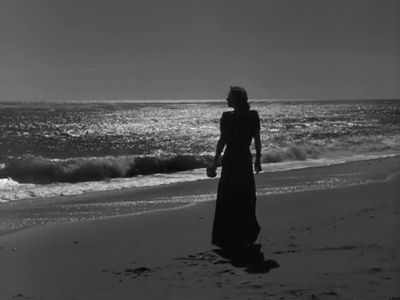
43 notes
·
View notes
Note
Topic: Lady Jane Franklin ????
Oh yes and with very great pleasure, she was a fascinating woman. Quite the opposite what the society expected from her and yet she stood her man. Since I did not quite know what exactly you wanted from her, I simply chose her biography to give an insight into her life. But please don’t be angry if I put the whole thing under the continuereading line at some point, but the text is really very long and with the pictures even longer. But I hope you like what I wrote about her.

Lady Jane Griffin (Franklin) (1791-1875)
Jane Griffin was born as one of three daughters of John Griffin and Mary Guillemard on 4 December 1791. She was very well educated at home and thanks to her father could travel a lot early on, which she also did with passion, and was a very good friend of Eleanor Anne Porden, who was married to John Franklin and gave birth to him a daughter. Unfortunately she died on 22 February 1825, only six days after John left her for an Arctic expedition. When he returned in 1827, he became known as the man who had eaten his boots, and had to realise that his wife had died of tuberculosis. His daughter Eleanor was meanwhile raised by her friend Jane. The two quickly came together and already in 1828 they were engaged and married in November of the same year, even if it was only a small and very quiet marriage. Less than five months later she became Lady Jane Franklin because John was knighted. And she was always called Lady Franklin, never Lady Jane.
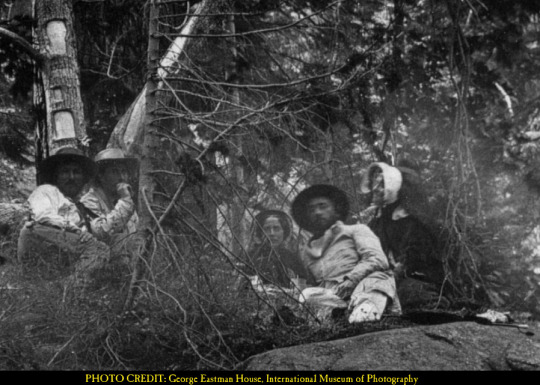
Interestingly, it is always said that she had never been photographed. But that’s not true, there is a single picture of her together with her niece. Sophia is the one in the middle and Lady Franklin sits on the side.
From 23 August 1830 to 1834 John left her alone in England as he commanded the Rainbow, 28 guns, and then stayed in the Mediterranean. Jane didn’t let this bother her either, but she accompanied her husband from time to time, but mostly used her free time and travelled to Africa, Syria and Asia. An incident brought her a little more trouble with her husband. She sailed on the Nile and met a young man named Johann Lieder. A smart young portestant missionary. He flirted very strongly with her and even lay down with her on a blanket. She even wrote all this in her diary, but she lacked this certain kind of passion which led to the conclusion that she had also had sex with him. Rather, she seemed to have no interest in sex at all, suggesting that she might have been asexual. Since her marriage was also free of children. The society had rather suspected John and there were even rumours in the circles in which the two moved that he allegedly froze his hangings during his Arctic expedition. But what really was the reason why the two had no children and whether she really had no interest in sexual activities can definitely not be said today.

Lady Jane Franklin, by Thomas Bock 1838
When John was promoted to Lieut. Governor of Van Diemen’s Land (Tasmania) in 1836, it didn’t take long for Jane to follow him with his niece Sophia Cracroft. Who was to live with them from then on. Jane saw Van Diemen’s as an opportunity to become active there and tried everything to change this island culturally and socially. Especially the female prisoners had done it to her. So she tried to give them a second chance with education and tried it instead of punishment with resocialization. John gave her his consent and so she could decide relatively freely and do what she wanted. Jane even founded a museum, a scientific society that became the first Royal Society for the Advancement of Science outside the UK. She also founded a scientific journal, a boys’ school, a botanical garden, an art gallery, a farm for peasants in the Huon. She paid one shilling per capita to get rid of snakes. She adopted Aboriginal children to see what happened when they were “civilized” - although she paid little attention to them herself and left “civilization” to others.
Only the men of society didn’t like that and so she, but also John, was repeatedly pointed out what kind of role she had to play and that would be a passive one. Also her very offensive flirting with Captain James Clark Ross, when he stopped in Tasmania to start his Antartis expedition, was considered too daring and was openly admonished to refrain. Ross but also Franklin didn’t seem to mind that much. At least there are no written statements or official reports about it.
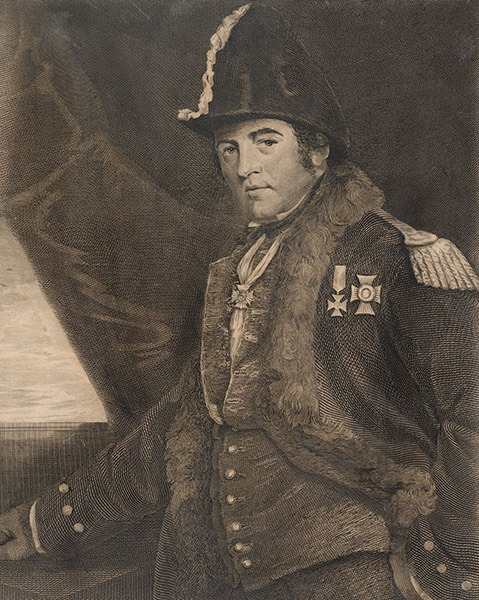
Sir John Franklin, portrait by E.P. Hardy, engraved by D.F. Murphy, ca 1845
She was also interested in research. She was the first European woman to climb Mount Wellington and travelled by land to Macquarie Harbour on Tasmania’s wild west coast. On the mainland, Franklin travelled from Melbourne to Sydney, which in 1839 was considered a difficult journey and probably the first woman to do so. In 1841 she visited South Australia and New Zealand, taking countless notes on everything she observed. When John was called back under shabby circumstances in 1843 and heard that John Barrow, the Admiralty’s polar research man, was planning another search for a Northwest Passage, he strongly supported the command and got it. HMS Erebus and Terror and 129 crew members started in May 1845 with a big fanfare from the Thames, but they could not be seen again by any of their countrymen. In this time she travelled together with Sophia to America.
After two years without a word Jane took over the reins and began to ask the admiralty to conduct search expeditions. The earliest, ordered by James Clark Ross, was sent out in 1848, and it was only the first of about 40 expeditions that would search land, ice and seas in vain for 11 years. Many of the searches took place with Royal Navy ships under admiralty orders, but six were with ships owned or financed by Jane, using commanders and crews selected and paid by her. She even wrote to the US President and her wealthy American friend, Henry Grinnell, whom she had visited in 1846, asking for her help, and they responded by sending two ships owned by Grinnell and manned by the US Navy.
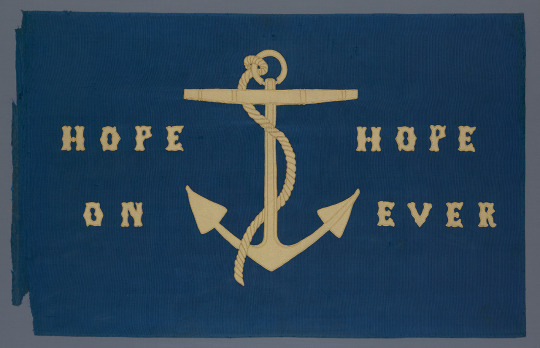
A sledge flag embroidered with Sir John Barrow’s motto ‘HOPE ON HOPE EVER’ made by Lady Jane Franklin for Lieutenant Bedford Pim. It was flown from HM sledge ‘John Barrow’ commanded by Pim when he made contact with the crew of ‘Investigator’ on 6 April 1853, during the Belcher Franklin search Expedition 1852-1854
The Royal Navy abandoned the search in 1855 after John Rae, the land explorer, brought artifacts from the Franklin ships acquired by the local Inuit, stories of men dying attempting to migrate south, and even reports of evidence of cannibalism. The accusation of cannibalism outraged Lady Franklin - English did not do such things, not under John Franklin’s supervision - and she purchased another ship, a luxury yacht, which Fox converted and dispatched with the experienced Arctic explorer and sled master, Francis McClintock. It was this expedition that finally found on 6 May 1859 a pile of stones with a document certifying that Erebus and Terror had been abandoned, the men now on foot, and that John Franklin had died on 11 June 1847. Jane could now rest, now that John was in peace.
The past years had been very exhausting for her and she started to travel again with the certainty that John would not come again. So in 1860 her way led her to New York and from there to Canada. But she was also awarded with the Royal Geographical Society’s Founder’s Gold Medal in that year. She surrounded Cape Horn and travelled again a while through America (San Francisco, Victoria and so on) until she travelled to the next one, via Hawaii, to Japan and finally to India.
But the year 1865 was a hard year for her because she heard rumours from Charles Francis Hall that there were still survivors of Franklin’s expedition based on Eskimo reports. She wanted to question him personally, and when she learned in September 1869 that he had returned from King William Island and relied on it with others, they set off with Sophia to meet him in the United States.
They circumnavigated Cape Horn again, stopped again in San Francisco, and then travelled further north on the Newborn steamship at the end of April 1870. After a few days among old friends in Victoria, they drove up the west coast to Alaska. On May 10, they stopped in Tongass and two days later reached Sitka, where they spent a month. In Cincinnati, Ohio, and later in New York, they reached the big destination of their journey, interviews with Hall. Unfortunately, no record of what happened between them has survived. At the time of their meetings Hall’s plans to reach the North Pole had been worked out, but he obviously agreed to renew his search for survivors later on or near King William Island.

Memorial for Sir John Franklin, Westminster Abbey, erected by Lady Jane Franklin, 1875
Already when she was in the 1980s, Lady Franklin’s attention was still firmly focused on Arctic affairs, and in 1875 she was actively interested in the preparations of George Strong Nares’s expedition to the North Pole and in particular Allen Young’s proposed search for Franklin’s plates. Among her ultimate concerns was the erection of a monument to her husband in Westminster Abbey, which was unveiled two weeks after her own death. It bore in part these words: “…erected by Jane, his widow, who, after long waiting and many in search of him, set out herself to search for him and find him in the kingdom of light…”. She died on July 18, 1875. At her funeral on July 29, among the palace bearers were the Captains McClintock, Collinson and Ommanney, R.N., as well as many other “Old Arctic” involved in the Franklin search. She was buried on the Kensal Green Cemetery in a tomb, West London, next to her sister Lady Mary Simpkinson.
90 notes
·
View notes
Text
Headlines
Optimism fades that jobs lost to virus will return (AP) Nearly half of Americans whose families experienced a layoff during the coronavirus pandemic now believe those jobs are lost forever, a new poll shows, as temporary cutbacks give way to shuttered businesses, bankruptcies and lasting payroll cuts. It’s a sharp change after initial optimism the jobs would return. In April, 78% of those in households with a job loss thought they’d be temporary. Now, 47% think that lost job is definitely or probably not coming back, according to the latest poll from The Associated Press-NORC Center for Public Affairs Research. That translates into roughly 10 million workers who will need to find a new employer, if not a new occupation. The poll is the latest sign the solid hiring of May and June, as some states lifted stay-at-home orders and the economy began to recover, may wane as the year goes on. Adding to the challenge: many students will begin the school-year online, making it harder for parents to take jobs outside their homes.
Watchdog to review conduct of federal agents in Portland, DC (AP) The Justice Department inspector general said Thursday that it will conduct a review of the conduct of federal agents who responded to unrest in Portland, Oregon and Washington, D.C., following concerns from members of Congress and the public. The watchdog investigation will examine use-of-force allegations in Portland, where the city’s top federal prosecutor and mayor have publicly complained. In Washington, investigators will look at the training and instruction provided to the federal agents who responded to protest activity at Lafayette Square, near the White House. Among the questions being studied are whether the agents followed Justice Department guidelines, including on identification requirements and in the deployment of chemical agents and use of force. The investigation was announced amid ongoing chaos in Portland, where Mayor Ted Wheeler was tear-gassed by federal agents as he stood outside the courthouse there. Local authorities in both cities have complained that the presence of federal agents have exacerbated tensions on the streets, while residents have accused the government of violating their constitutional rights.
FBI interviewing Chinese visa holders across U.S. about possible military ties: Justice Department (Reuters) The FBI has interviewed visa holders it believes to secretly be members of the Chinese military in more than two dozen U.S. cities, the Justice Department said on Thursday. The department said it has arrested three Chinese nationals for visa fraud, while a fourth remains a fugitive staying at China’s consulate in San Francisco. The United States believes the four were members of China’s military posing as researchers. “In interviews with members of the Chinese People’s Liberation Army in over 25 cities across the U.S., the FBI uncovered a concerted effort to hide their true affiliation to take advantage of the United States and the American people,” John Brown, executive assistant director of the Federal Bureau of Investigation’s national security branch, said in a statement.
The coming plastic-covered beach (Bloomberg) The annual flow of plastics into our oceans is on a trajectory to triple over the next 20 years, which could add up to 110 pounds of plastic trash for every meter of coastline worldwide, a new report finds. That path is not inevitable, however. The volume could be cut by 80%, the analysis found, by taking actions to reduce the growth of virgin plastic production, improve waste collection systems across the globe, and invest in the creation of plastic materials that are easier to recycle.
New York street partying fuels fears of coronavirus resurgence (The Guardian) Motorcycles revved, waiters served drinks, and food in busy outdoor street seating areas and, on the pavement, people gathered to sip to-go drinks. On Saturday night in Astoria, in Queens, it was almost as if coronavirus had never hit New York City. In April, the city was the center of the global coronavirus pandemic, with the daily death toll reaching almost 800 people at its height. But as cases of Covid-19 have steadied and lockdown restrictions have eased, this stretch of Steinway Street has emerged as an unofficial party street. But standing on the other side of the road from Mehmood in Astoria, outside a barber shop, Omar Melendez, 39, who has a newborn at home, said he was “living in fear”.
Thousands in Puerto Rico still without housing since Maria (AP) Nearly three years after Hurricane Maria tore through Puerto Rico, tens of thousands of homes remain badly damaged, many people face a hurricane season under fading blue tarp roofs and the island’s first major program to repair and rebuild houses hasn’t completed a single one. Maria hit more than 786,000 homes on Sept. 20, 2017, causing minor damage to some homes and sweeping others from their foundations. A federally funded program administered by local officials carried out relatively small repairs to some 108,000 homes the next year, while churches and nonprofits patched up thousands with private funds. A Puerto Rican government program known as R3 is the first major effort by the U.S. territory to carry out major repairs and rebuilding of damaged and destroyed housing. Nearly 27,000 homeowners have applied. But nearly 1 1/2 years after federal funding was released to local officials, not a single repair or rebuilding job has been completed. For many Puerto Ricans, the program’s slow progress has become a symbol of their government’s inability to address the long-term effects of the disaster. “They talk about billions of dollars, but we’re not seeing it,” said Sergio Torres, mayor of the northern mountain town of Corozal. His municipality still has 60 homes with blue tarps as roofs and two families still living in school shelters. “It’s a way of life here.”
Latin America’s beach towns isolate themselves to keep the coronavirus out (Miami Herald) Before the pandemic, thousands of people left the capital city of Santiago, Chile, every weekend to head to Los Molles. They filled the hotels and bars run by the town’s 648 permanent residents. It was a reliable and amicable relationship: The tourists came for the beaches and laid-back fishing village vibes, and their spending fed the Los Molles economy. When coronavirus quarantine measures were announced, Santiago residents fled to their beach vacation homes midweek, hoping to escape a claustrophobic quarantine in the capital and relax in Los Molles. But they found flaming barricades made of wood and tires, billowing tar-thick smoke and blocking the highway entrances leading into town. If the flaming barricades didn’t get the message across, the volunteer guards let anyone who wasn’t a permanent resident know this wasn’t the time for a beach vacation and sent them away. Los Molles is among a handful of small tourist towns in Latin America that have decided on isolation to protect themselves against the coronavirus pandemic. Remote beach towns in Mexico have used the same strategy. Residents of these small communities say the measures have worked. Los Molles residents said that with community organizing they have avoided any infections as of late July despite being two hours outside Santiago, which is now a global COVID-19 hot spot.
Bolivia election delayed to October as pandemic bites (Reuters) Bolivia’s general election will be pushed back until Oct. 18 as the pandemic grips the South American nation, a move that could fan tensions between the interim conservative government and the socialist party of former President Evo Morales. The head of the electoral tribunal said on Thursday that the vote would be postponed from the previously scheduled Sept. 6 date to ensure the safety of voters, with hospitals and cemeteries straining under the impact of the virus. The vote is key to the political future of the Andean nation of 11.5 million people after a fraught election last year sparked widespread protests and led to the resignation of the country’s long-term leftist leader Morales.
Brazil reports record infections as coronavirus spreads to all regions (Washington Post) There was a time, weeks ago, when Carlos Renan dos Santos Evaldt allowed himself to hope. Much of Brazil was in varying states of chaos as the novel coronavirus devastated the country’s largest cities. But it had largely spared the wealthier, more developed south. But after a surge in cases and deaths, his city is considering imposing a lockdown. The pockets of Brazil that had been largely unscathed by the virus—the south, the vast central states—have been engulfed by it. The sheer relentlessness of the surge here underscores Brazil’s failure to quell the world’s second-worst coronavirus outbreak. On Wednesday, Latin America’s largest country posted a record 67,860 new cases, bringing the total infected to 2.2 million, with nearly 83,000 dead. Both counts are second only to the United States.
Thailand protest movement puts country’s youth on collision course with military-backed establishment (CNN) Thailand’s student movement has reignited, as young people across the country defy threats from the military-backed government to take to the streets and call for the resignation of Prime Minister Prayut Chan-o-cha. In what was the biggest demonstration since the pandemic began, about 3,000 people gathered at Bangkok’s Democracy Monument on Saturday, according to organizers. They called for the dissolution of parliament, for the constitution to be rewritten, and for authorities to stop intimidating activists. Similar demands were made at smaller protests that sprang up in towns and cities across the country every day this week, with more planned for the coming days. The protests come after years of political upheaval marked by a military coup in 2014, followed by failed promises to restore democracy, and what activists say is a repression of civil rights and freedoms.
Iranian Civilian Jet Swerves to Avoid American Warplane in Syria (NYT) An Iranian passenger plane en route from Iran to Beirut swerved and dropped abruptly on Thursday to avoid a nearby American fighter jet, injuring several passengers before landing in Beirut. Videos broadcast by Iranian and pro-Iran Lebanese media, which said the footage was taken by passengers, showed a fighter jet flying alongside the passenger plane, operated by Mahan Air, a privately owned Iranian airline. Passengers then screamed as sudden turbulence seized the plane. In the aftermath, one video showed a passenger with his face and head bloodied, as well as a man lying down, apparently unconscious, while someone tended to him. Oxygen masks dangled overhead. Capt. Bill Urban, a spokesman for the U.S. Central Command, said in a statement later Thursday that an Air Force F-15 on “a routine air mission” near a small American military base in southern Syria had conducted “a standard visual inspection of a Mahan Air passenger airliner.”
Israeli police use water cannons on protesters, arrest 55 (AP) Israeli police used water cannons to disperse protesters in central Jerusalem and arrested at least 55 of them as clashes broke out overnight after thousands staged a protest against Prime Minister Benjamin Netanyahu. Israelis have held a series of demonstrations in recent weeks calling on Netanyahu to resign, citing his trial on corruption charges and his fractious unity government’s poor handling of the coronavirus pandemic.
Cut off from world, and virus, Gaza prepares for Eid like nowhere else (Reuters) Gazans are thronging beaches and crowding markets filled with holiday sweets and clothes as they prepare to celebrate Eid al-Adha largely free of the coronavirus restrictions affecting the Muslim festival elsewhere. The 360 sq. km. coastal strip has had little access to the outside world for years due to an Israeli-led blockade which many Palestinians say is like living in permanent lockdown. No cases have been recorded in the towns and refugee camps where its two million Palestinian population live. The result is that Gazans are preparing much as normal ahead of Eid, which begins at the end of July, with few people wearing masks in shopping centers that are packed after sunset. “God protected us from the virus,” said Malkeya Abdallah, 62, as she relaxed on the beach near Gaza City.
1 note
·
View note
Note
About your griffin post, about it being Protoceratops... It's not true. Mark Witton did an in-depth discussion about it.
Yes, about that - as I said in the notes, I’m grateful to the person who posted the link because I’d never heard of any of that, and the more diverse perspectives on stuff, the better. That said, a few things about his rebuttal (and yours):
1. When it comes to religion, mythology and folklore studies, there’s no such thing as ‘true’ and ‘not true’. You can categorize theories with other words, such as ‘likely’, ‘probable’, ‘possible’ and ‘utter troll dung’, but those are not exact sciences, so while it’s possible to follow a rigorous and scientific approach, it’s difficult (or even impossible) to prove anything in a definite way.
2. Adrienne Mayor’s book had an interdisciplinary approach. Mark Witton’s article did not. Now, this is more to Mayor’s credit than to Witton’s demerit, because you’re not going to contact fifteen colleagues for a blog post, but it’s worth noting that the lack of interdisciplinary research is a huge problem in academia, and it’s especially noticeable in ancient history (or maybe I notice it more because it’s my field, I don’t know). Since people tend to be either word-minded or numbers-minded, what you get is a series of extremely well-prepared specialists looking at stuff - while being completely ignorant of 98% of the world they’re examining. An ancient Greek scholar, for instance, will know a lot about linguistic shifts but squat about bread making, and that’s a bad way to understand a whole culture. Mayor, who’s more on the word side of the equation, made an effort to consult with science-oriented colleagues; Witton didn’t do that (although, as I said, that’s perfectly normal for the writing format he was using) and it shows.
3. About his first argument, ie that griffins are found in Near Eastern art: who cares? What you need to do here is not look at how you see the world, but at how a Greek person would see the world. Near Eastern griffins are not relevant - not because they don’t exist (they do) or because they’re not objectively fascinating (they are). They’re not relevant because they’re not mentioned in this context by Greek texts. None of the authors Mayor discusses made a connection between the Central Asia griffins and the Persian griffins. Maybe they didn’t know about the other ones, maybe they saw them as different animals - I honestly don’t know. But if they didn’t draw a connection between the two thing, then neither should we. I know mythology books tend to have categories on ‘monsters’ and offer enthralling images of ‘sirens’, ‘giants’ and ‘demons’ from around the world, but the fact is, how a specific culture understands that monster is likely to differ a lot from what their neighbours think of them. Sphinxes are a good example. There’s the Egyptian sphinx and the Greek sphinx - those are never discussed in the same papers because, despite the fact they do have superficial similarities, they’re very different creatures in what concerns their role in their respective societies’ religious and conceptual landscapes.
4. About his second argument, ie that protoceratops bones are not as widespread as she suggests, and one wouldn’t trip on skulls every two seconds - again, so what? As long as those fossils can be placed in that area at the right time, I’m good. This is not a scientific experiment the Scythians are carrying out: one skull is enough to suggest a story behind it, one trader sharing that story in his travels is enough to make it grow, and one bartender telling Herodotus about it is enough to validate it. The Amazons are a very good example of how that works. The idea of a tribe of women warriors had fascinated the Greek for centuries (they’re mentioned in the Iliad) before Herodotus wrote about them confirming they were real people doing real stuff. Western scholars have been scoffing at him ever since - and they kept scoffing until Soviet archaeologists started finding graves of women who’d been buried with weapons. Now - did archaeologists ever find a cemetery that was 100% badass female warriors? No. Did they find a cemetery that was 50% female warriors? Also no. To the best of our current knowledge, some of those Siberian-based tribes had - occasionally - warrior queens, or high-status women who used weapons. They were not Amazons in the traditional sense of the word, but it’s not that hard to imagine what must have happened there: one foreign delegation headed by an armed queen would have been enough to make any Greek go wtf and ooooohh, because that would have been so exotic - Greek women didn’t use weapons (and neither did Persian women, or Egyptian women - cultures some Greeks would have been familiar with) - so the sight of that must have left quite a deep mark. And since that’s how humans work, one warrior queen can become ‘a whole race of man-hating badass women’ in two seconds flat. I mean, we know that’s how storytelling works, and what happens with dubious or spotty record keeping, but also - how many times has that happened to you? You meet one Korean guy, he’s the only Korean you know and he’s an asshole - before you know it, you start to assume that’s what all Koreans are like. It’s just how we’re wired, and I guess it was supposed to be about protecting us from poisonous plants (‘Sure, that other red berry almost killed my brother, but what about this one?’ - that would have seen us extinct in no time), but it’s also something we need to keep in check, because no - people are not ‘all the same’ just because they belong to the same ‘tribe’.
5. Another argument he makes is that Central Asia to Greece is rather a long distance for Chinese whispers and legend swapping, and that’s so wrong I don’t even know what to say. This is exactly what I meant when I said people can be experts in their field (in Witton’s case, paleontology) while being pretty ignorant about others, because the ancient world was way more connected than what we imagine it to be. We know that even in prehistoric times, there were crowded trade routes moving from the Baltics to Greece, that people travelled hundreds of miles to go to some sanctuary on a Scottish island, and that yeah - ideas and legends did travel with goods, sometimes in a very lasting way. The traces of Buddhist doctrine, for instance, are all over Greek philosophy. This is a subject that’s only recently been explored because people like to believe Greek culture was born fully-formed without any foreign influences, but the studies on the exchanges between India and Greece - well before Alexander’s times - are fascinating. So no, I’m not disturbed in the slightest by the fact news about ‘griffin skulls’ seem to have travelled from the Gobi to Athens. That stuff happened, and as I mentioned above, all you need is one person - one guy who’s well-spoken enough, convincing enough, or convinced enough - one guy who doesn’t want Greek traders anywhere near his gold-stuffed mountains - talking to a second person. Today we’ve only got about 10% of Greek literature, but Greeks were an inquisitive bunch, and the country was littered with self-styled historians, geographers and anthropologists who spent their time either traveling around or paying drinks to whomever seemed foreign enough to be interesting. That method has limits, by the way - I myself once invented a fair bit of my town’s history because I was sixteen and bored and those tourists had seen me with my Latin textbook and asked me if I knew anything about Roman settlements in the area, so. I mean - half of a Greek historian’s paragraph start with ‘A man in Samos told me’ - God knows who they were even talking to. A local priest keen to increase tourism, the village idiot - anything’s possible.
6. Finally, something else that’s just uh is how Witton says, why single out griffins? What about other monsters? And, well, that’s the whole point of Mayor’s book. We know for sure ancient people found fossils; what we’re trying to figure out is what impact (if any) that had on their worldview. For instance, fossils did not suggest the idea of evolution, but they did mess with (or confirm) some of their religious beliefs. I’m hoping to summarize other chapters of Mayor’s book in more detail, but just a couple of examples: the Greeks, like many other ancient people, believed their ancestors to have been much taller and stronger than themselves -
(This, by the way, it’s another tantalizing way the outside world may - or may not - have influenced thought and belief: did the Greeks believe that because of the monumental architecture older cultures had left behind, or did those staggering things confirm an idea that had sprung from a different source? Like, humans tend to be pessimistic mofos, so it’s plenty possible you’d assume people are becoming smaller and weaker just because, and next the finding of a Daedalic temple just confirms that for you, because how the hell could anyone built that and Jesus Christ? Or maybe you find that temple first, and adjust your theology accordingly. We just don’t know. Hell - we’re struggling to explain contemporary religious phenomena - everything and anything from ISIS to spontaneous lynchings in India to cults - we have zero chance of fully understanding Greek religion in a way that allows us to say, ‘that’s right’ or ‘that’s wrong’.)
- and they also believed in monstrous giants dying in riverbeds (many Greek rivers are named after giants). Both things are probably related to the giant-ass femurs which kept cropping up in fields and - well - riverbeds, so no - griffins are not the lone exception. We know of people finding stuff they assume to be giant bones, divine cattle, cyclops - if you can think of it, there’s probably a fossil for it.
Ultimately, I just want to say: Mayor does offer some rather sweeping statements, but, then again, her book is aimed at a general audience. Too many conditionals and no one’s buying it (or understanding it). On the other hand, she also never pretends to hold any Universal Truth over the subject she’s exploring, because that’s how (good) academia works: you expect (and encourage) rebuttals, corrections, discussions. That’s how we progress.
Personally, what attracts me to these theories is that they’re part of a movement that’s arising - bloody finally - acknowledging man is not the centre of the known and unknown universe.
Until very recently, we were told the physical world has zero influence on what we think and how we feel - because we’re a superior animal, that is, so that stuff doesn’t touch us in the same way it does other (lower) beasts. And while that is true to an extent - if there’s an inconvenient river, we move it - saying that the world around us has no impact on our souls, brains and way of life - that’s just laughably pretentious. We now know something as banal as the weather can completely transform our mood and our decision-making, even on the long term - that trees make us smarter, that urban landscapes are likely to give migraines - there are studies in experimental archaeology in how landscape influences thought (like, you bury someone in a fetal position because the ground is too hard, you make yourself feel better by imagining he’s like a baby in the mother’s womb and will one day be reborn), and a lot of new ideas about folklore and religion. This line of studies on fossils is one example of that; another is how geography impacts theology - I don’t remember who it was, but I know someone suggested the reason human sacrifice is more common in tropical cultures is because in a jungle, death will immediately (and very visibly) feed new life, whereas in colder climates the relation is not that apparent. And again, it may never be possible to prove right and wrong there. Even if we had a time machine, these things are tricky to understand. People think of faith and belief in different ways, approach their religion through their own filter, will pretend to go along with stuff for personal gain. Who knows. The only thing we can be sure of is that those fossils would have been understood differently by different people. To some, that would have been proof of mythical monsters. To others, a way to strengthen their flock’s faith and thus cement social cohesion. And to others still, it was probably just a way to make money - a temple displaying a ‘griffin skull’ would have led to people selling griffin statues and opening griffin-themed restaurants, same as you see today in places like Lourdes or Fatima. Humans are messy. History is messy. That’s what’s beautiful (and infuriating) about both.
#ask#griffins#mythology#greek mythology#religion#mark witton#sorry i'm not including links#i'm late for a job#gaaaaaah#i hope this made sense?#but i'm open to discuss this of course#witton's perspective was genuinely interesting
200 notes
·
View notes